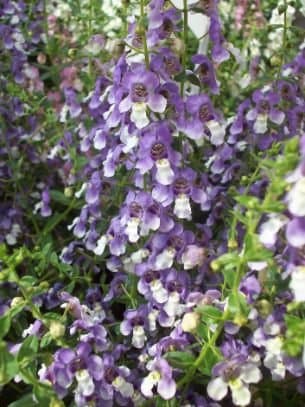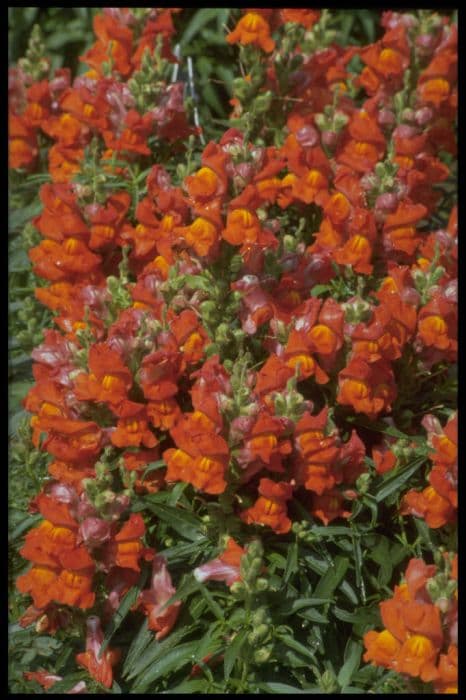Hebe Frozen Flame Hebe 'Frozen Flame' (v)

ABOUT
Hebe 'Frozen Flame' is a striking ornamental plant characterized by its vibrant foliage and captivating blooms. The leaves of Hebe 'Frozen Flame' are particularly noteworthy for their dynamic coloration. The foliage presents a mix of colors starting with a deep green at the base, transitioning to a creamy white, and often edged with pinkish hues that intensify during the cooler months, mimicking the appearance of a flame that has been frosted over. As the plant matures through the seasons, the leaves can develop a range of colors, ensuring a continually changing display. The dense, glossy leaves grow in a compact, rounded shape, creating a lush and tidy appearance. Flowers emerge on this plant in the form of small, dense spikes. The blooms are a soft lilac to violet shade, adding a delicate contrast to the boldness of the leaves. The overall impression of Hebe 'Frozen Flame' is one of vivid contrasts and striking beauty, with its unique foliage that seems to capture and play with the light and charming flowers that attract a variety of pollinators. This colorful plant is widely appreciated for its year-round interest and its ability to bring a splash of color to garden settings.
About this plant
 Names
NamesSynonyms
Frozen Flame Hebe, Variegated Hebe, Shrubby Veronica
Common names
Hebe 'Frozen Flame'
 Toxicity
ToxicityTo humans
The Hebe plant is generally considered to be non-toxic to humans. There are no well-documented cases of poisoning from ingestion of Hebe plants, and they are not known for containing toxic substances that could cause harm to humans. Consequently, if ingested, they are unlikely to produce more than a mild stomach upset, if any symptoms at all. However, all plants can potentially cause reactions in certain individuals due to allergies or individual sensitivities, so it is always best to avoid ingesting plants that are not explicitly meant for consumption.
To pets
The Hebe plant is regarded as non-toxic to pets. It does not contain any known compounds that are poisonous to animals such as dogs and cats. If a pet ingests part of a Hebe plant, it is unlikely to experience any serious symptoms. As with humans, there could be a risk of mild gastrointestinal upset, like vomiting or diarrhea, especially if a pet eats a large quantity of the plant. Generally, this plant is considered safe for pets, but it is always advisable to keep an eye on your animals and ensure that they do not consume large amounts due to the risk of digestive issues or potential unknown individual reactions.
 Characteristics
CharacteristicsLife cycle
Perennials
Foliage type
Evergreen
Color of leaves
Variegated
Flower color
White
Height
1-2 feet (30-60 cm)
Spread
1-2 feet (30-60 cm)
Plant type
Shrub
Hardiness zones
8
Native area
New Zealand
Benefits
 General Benefits
General Benefits- Attractive Foliage - Hebe 'Frozen Flame' boasts variegated leaves that can add visual interest to any garden or landscape.
- Low Maintenance - This plant requires minimal care once established, making it ideal for those who want an attractive garden without constant upkeep.
- Drought Tolerance - Hebe 'Frozen Flame' is relatively drought-tolerant, meaning it can thrive even in drier conditions.
- Seasonal Interest - It offers a variety of colors throughout the seasons, providing year-round interest in the garden.
- Compact Size - Its compact growth habit makes it suitable for small gardens or as part of a mixed border.
- Wildlife Attraction - The flowers can attract bees, butterflies, and other beneficial insects, supporting local biodiversity.
- Versatile Planting Options - It can be used in a range of garden situations, including containers, borders, and as informal hedging.
- Evergreen - Being an evergreen shrub, it ensures that your garden remains green and vibrant all year round.
 Medical Properties
Medical PropertiesThis plant is not used for medical purposes.
 Air-purifying Qualities
Air-purifying QualitiesThis plant is not specifically known for air purifying qualities.
 Other Uses
Other Uses- Decorative topiary: Hebe 'Frozen Flame' can be pruned into various shapes for artistic topiary displays in formal gardens.
- Themed gardens: Incorporated in fantasy-themed gardens to add a whimsical touch due to its unique foliage coloration resembling ice and fire.
- Photography backdrops: Used as a vibrant backdrop for outdoor portrait photography due to its striking leaf colors.
- Craft supply: The branches and leaves can be used in floral crafts, such as wreath making or table centerpieces for events.
- Erosion control: Planted on slopes or in areas prone to erosion to help stabilize soil with its root structure.
- Seasonal container displays: Utilized in container gardening to provide winter interest with its colorful foliage.
- Wedding decor: Fresh or dried leaves used for decorating wedding venues, especially for nature-themed weddings.
- Insectary plant: Although not recognized for pest-repellent properties, its flowers can attract beneficial insects to the garden.
- Fairy gardens: A suitable addition to miniature fairy gardens due to its small size and colorful appearance.
- Cold climate gardening: Suitable for gardens in cooler climates where its frost-resistant nature can be an advantage.
Interesting Facts
 Feng Shui
Feng ShuiThe Hebe plant is not used in Feng Shui practice.
 Zodiac Sign Compitability
Zodiac Sign CompitabilityThe Hebe plant is not used in astrology practice.
 Plant Symbolism
Plant Symbolism- Enduring Love: Hebe, in Greek mythology, is the goddess of youth and represents everlasting affection, making the 'Frozen Flame' variety emblematic of love that withstands the test of time.
- Resilience: The 'Frozen Flame' part of its name implies an oxymoron of cold and hot elements, signifying the ability to endure and adapt through contrasting or difficult situations.
- Transformation: The contrasting colors of the plant, changing from cool to warm hues, symbolize change and the embracing of new phases in life.
- Protection: Historically, hebes were said to offer protection, and the 'Frozen Flame' can represent shelter against adversity.
- Inspiration: With its striking flame-like blooms amidst the frosty-looking foliage, it can inspire creativity and spark enthusiasm in life's endeavors.
 Water
WaterThe Veronica 'Frozen Flame', also commonly known as Hebe 'Frozen Flame', prefers consistent moisture, so it is best to water it when the top inch of soil feels dry to the touch, which is typically once a week. Provide enough water to moisten the soil thoroughly but ensure that the pot has good drainage to prevent root rot. During the growing season, in spring and summer, this might mean watering the plant with approximately 16 - 24 ounces of water on a weekly basis. In the fall and winter, reduce the watering frequency to every other week with the same amount, allowing the topsoil to dry out slightly between waterings. Adjust the watering schedule according to the humidity and temperature of your environment to ensure the plant stays healthy.
 Light
LightTo maintain the vibrant foliage of the Hebe 'Frozen Flame', it should be placed in a location that receives full to partial sunlight. Ideal light conditions include at least six hours of direct sunlight, which helps to encourage flourishing growth and maintains the coloration of the leaves. When growing indoors, a south-facing window makes a suitable spot, but if the light is too intense, especially in summer, consider diffusing it with a sheer curtain to avoid leaf burn.
 Temperature
TemperatureThe Veronica 'Frozen Flame' thrives in moderate temperatures, with ideal conditions ranging between 50 to 68 degrees Fahrenheit. While it can tolerate temperatures down to about 20 degrees Fahrenheit, it prefers to avoid the extremes of hot and cold. Ensure protective measures during frosts or extreme heat, as prolonged exposure to temperatures below 20 degrees or above 80 degrees Fahrenheit can lead to damage or stress for the plant.
 Pruning
PruningPruning the Hebe 'Frozen Flame' is necessary for maintaining its shape and promoting new growth. Prune in late winter or early spring, before new growth starts, by cutting back any dead or damaged stems to healthy outward-facing buds. Also, after flowering, trim back the flower spikes to encourage a second bloom and to keep the plant looking tidy. It's often sufficient to prune the plant once a year, but if it grows vigorously, a light trimming in the summer can keep it in shape.
 Cleaning
CleaningAs needed
 Soil
SoilThe best soil mix for Hebe 'Frozen Flame', commonly known as Veronica, is well-draining soil with a slightly acidic to neutral pH between 6.0 and 7.0. Incorporate organic matter such as compost or peat moss and ensure good drainage by adding perlite or sand to the mix.
 Repotting
RepottingVeronica should be repotted every 2 to 3 years or when it becomes root-bound. Early spring is the best time to repot to allow the plant to recover during the growing season.
 Humidity & Misting
Humidity & MistingVeronica plants, also known as Hebe 'Frozen Flame', thrive best in moderate humidity levels. Avoid extremely dry air, but there is no need for high humidity settings.
 Suitable locations
Suitable locationsIndoor
Place Hebe 'Frozen Flame' in bright, indirect light indoors.
Outdoor
Plant in partial sun to full sun and shelter from harsh winds.
Hardiness zone
7-10 USDA
 Life cycle
Life cycleHebe 'Frozen Flame', more commonly known as Veronica or Shrubby Veronica, starts its life as a seed that germinates under the right conditions of temperature and moisture. The seedling emerges with a basic set of leaves and develops a root system. As it matures into a young plant, it produces more foliage and begins to form the characteristic structure of woody stems and dense leaves. During its active growth period, the Hebe 'Frozen Flame' blooms, producing small flowers that can range in color, often attractive to pollinators. After pollination, if it occurs, seeds are produced, allowing for the potential of new plants to grow if they are dispersed to a suitable location. Hebe 'Frozen Flame' is a perennial, so after the blooming season, it will go into a dormant phase, particularly in colder climates, before resuming growth the following season.
 Propogation
PropogationPropogation time
Spring-Early Summer
Propogation: The Hebe 'Frozen Flame' can best be propagated through semi-hardwood cuttings, typically taken in late summer or early fall. To propagate, a gardener should select a healthy stem that has just begun to mature and firm up. A cutting of about 4 to 6 inches long should be snipped just below a leaf node. The lower leaves are then stripped off, leaving a few at the top, and the cut end can be dipped in rooting hormone to encourage root development. The cutting should be planted in a well-draining soil mix and covered with a plastic bag or placed in a propagator to maintain humidity. It is essential to keep the soil moist but not waterlogged and to place the setup in indirect light. Roots usually develop within a few weeks, after which the new Hebe 'Frozen Flame' can be gradually acclimatized to outdoor conditions.









